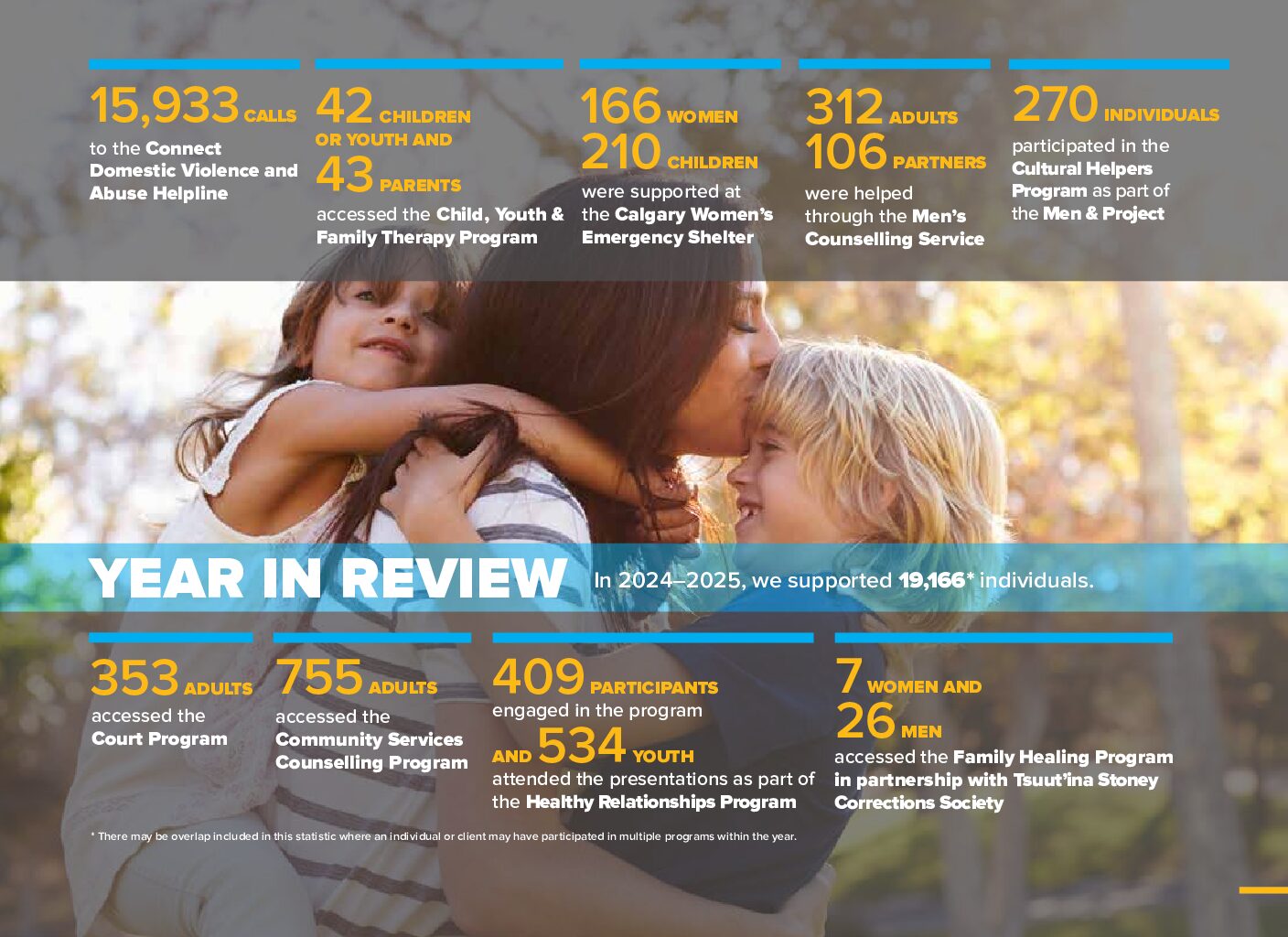Impact and Statistics

Click on these links for more information about our approach, programs and our accreditation.
General Statistics
It is important to note that many victims do not report their experiences to the police, resulting in underreported figures. It is estimated that 44% of women or 6.2 million women aged 15 and older have experienced some form of abuse in their intimate relationships (Government of Canada, 2022).
Approximately only one in five (19%) victims of spousal violence self-report their experiences to the police (Statistics Canada, 2022).
The police are notified of less than 30% of Intimate Partner Violence cases, and 44% of Canadian women report having been physically or sexually assaulted in an intimate relationship (Letourneau, Dawn, Barton, & Griggs, 2023).
Violence is more likely to occur against people who identify as women with disabilities, Indigenous women, women from visible minorities, or women who identify as LGBTQ+ (Government of Canada, 2022); Regardless of the type of intimate partner relationship, women constituted the majority (79%) of intimate partner violence victims (Statistics Canada, 2022).
Women and girls experienced family violence at more than twice the rate of men and boys (455 vs. 215), and intimate partner violence at over three times the rate (537 vs. 151) (Statistics Canada, 2023)
Calgary
59% of Calgarians are concerned about the rates of domestic violence. (Calgary Foundation, Quality of Life Report, 2024)
In 2023, there were 5,161 reported incidents of violent crime categorized as domestic-related. These incidents included 3 homicides, 426 sexual offenses, and 4,072 assaults. (Calgary Police Services, 2024)
For the entirety of 2023, Calgary Police Service received a total of 23,890 calls concerning domestic incidents, averaging approximately 1,990 calls per month (Calgary Police Service, 2024)
According to Calgary Police Service, three of the 21 homicides recorded in 2023 were domestic-motivated (Calgary Police Service, 2024)
Alberta
The rate of police-reported intimate partner violence against women in urban areas of Alberta is 535 incidents per 100,000 population. This is higher than the national average of 461 incidents per 100,000 population (Statistics Canada, 2022).
74% of Alberta report that they personally know at least one woman who has been sexually or physically assaulted. (This figure does not factor in the countless women who do not tell anyone about the assault(s) nore does it factor in any other type of abuse besides physical and sexualized violence.) (Canadian Women’s Foundation “Angus Reid Omnibus Survey”, 2012).
Canada
In Canada a women is killed by her intimate partner every 6 days. (Statistics Canada, 2019).
Family violence and abuse costs Canada an esitmated $7.4 Billion every year. (This figure is derived from costs associated with health care, criminal justice, social services, and lost wages/productivity.) (Canadian Woman’s Foundation.)
Police-reported data from 2021 indicates that 114,132 individuals aged 12 and over experienced intimate partner violence (IPV) in Canada (Statistics Canada, 2022).
In urban locations, the rate of police-reported intimate partner violence against women is 461 incidents per 100,000 population (Statistics Canada, 2022).
In 2021, the rate for female victims of police-reported family violence was 457 incidents per 100,000 population (Statistics Canada, 2022).
2021 was the seventh consecutive year of gradual increase in police-reported intimate partner violence (Statistics Canada, 2022).
There were 127,082 victims of police-reported family violence in 2021 (Statistics Canada, 2022).
References
Statistics Canada, “Victims of police-reported family and intimate partner violence in Canada, 2021,” 2022.
Statistics Canada, “Trends in police-reported family violence,” Ottawa, 2023.
Statistics Canada, “Brief: Statistical profile of intimate partner violence in Canada,” Ottawa, 2022.
Calgary Police Service, “4th Quarter 2023 Statistical Report,” City of Calgary, Calgary, 2024.
City of Calgary, “Calgary police indicate increase in inquiries for domestic supports during Family Violence Prevention Month”, Calgary, 2023.
Government of Canada, “Fact sheet: Intimate partner violence,” Women and Gender Equality Canada, 2022.
N. Letourneau, . L. M. Dawn, S. S. Barton and K. Griggs, “Service Providers’ Perspectives: Reducing Intimate Partner Violence in Rural and Northern Regions of Canada,” The Canadian Journal of Nursing Research , vol. 55, no. 2, p. 165–175, 2023.